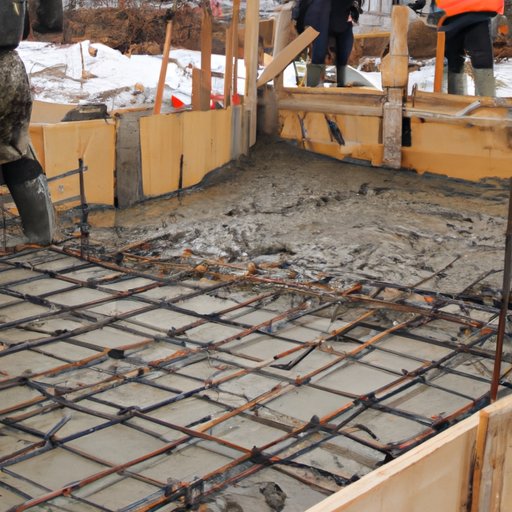
Introduction
Winter concrete pouring, also known as cold weather concreting, involves a unique set of challenges that require proper planning, preparation, and execution to achieve optimal results. This article explores the feasibility of pouring concrete during colder temperatures, highlights best practices to overcome its challenges, and discusses the benefits of winter concrete pouring for construction projects.
Seasonal challenges and solutions
One of the main challenges of pouring concrete in colder temperatures is that the mix has a reduced rate of hydration, which can result in lower strength, cracking, and other defects. To overcome this challenge, it’s essential to keep the concrete, tools, and materials warm using heating blankets or heated enclosures that maintain a temperature of at least 50°F (10°C) during the curing period.
Another challenge of cold weather concreting is selecting the right concrete mix. The mix should contain the right amount of water, cement, and aggregates that provide the necessary workability, strength, and durability. Using an admixture that accelerates the hydration process, such as calcium chloride, can also help reduce the setting time in colder temperatures and increase the early strength of the concrete mix.
Lastly, covering the freshly poured concrete with insulating blankets or tarps can help maintain its temperature and protect it from external factors such as wind, snow, and ice that can negatively affect the quality of the concrete.
Benefits of winter concrete pouring
Although winter concrete pouring comes with unique challenges, there are also several benefits that make it an attractive option for construction projects. One of the main benefits is that it enables contractors to pour concrete during a time when fewer projects are underway, resulting in shorter lead times and lower construction costs. Additionally, winter concrete has a slower curing rate, which means it will achieve higher strength levels and a longer service life.
Best practices for winter concrete pouring
Proper insulation, appropriate additives, and curing techniques are critical to achieving a successful winter concrete pour. Concrete should be protected from freezing for at least seven days by using proper insulation materials such as straw, blankets, or thermal blankets. Using additives such as air-entraining agents, plasticizers, or accelerators can improve the workability, reduce the setting time, and increase the early strength of the concrete. Finally, curing the concrete in a warm and moist environment for an extended period is essential for achieving optimal strength and durability. The curing process should last for at least 28 days.
Case study
A construction project that successfully poured concrete during the winter is The One World Trade Center in New York City. During the construction of the foundation, specifically the mat foundation, the concrete was poured in winter conditions. The project team used preheated concrete mix, covered it with insulating blankets, and kept the temperature above 50°F (10°C). They also used additives to accelerate the hydration and setting process, resulting in a successful pour.
Pros and cons of winter concrete
Like any construction-related method, there are pros and cons to pouring concrete during the winter. The advantages of winter concrete pouring include lower construction costs, increased strength and durability, and reduced lead times. However, some of the disadvantages include the difficulty of maintaining proper temperature and moisture levels, the risk of freezing, and the increased health and safety risks associated with working in cold weather conditions.
Frequently asked questions
What temperature can concrete be poured? Concrete should not be poured when the surrounding temperature drops below 40°F (5°C) for a sustained period. It should also have adequate protection against temperature fluctuations, wind, and moisture to avoid cracking and dimensional changes.
How long does it take for concrete to set in cold weather? Concrete will take longer to set and achieve strength in colder temperatures. It’s essential to use additives and proper curing techniques to accelerate the setting time. Typically, concrete will reach a strength of 70% in 7 days and 100% in 28 days with appropriate curing and insulation.
What are some safety precautions when pouring concrete in the winter? Contractors should take additional safety precautions when working in colder temperatures, such as wearing appropriate clothing, heating devices, and non-slip boots. They should have a thermal blanket or temporary structure in place to protect the freshly poured concrete from freezing or moisture.
Expert advice and tips
To ensure a successful winter concrete pour, consult with experienced professionals who specialize in cold weather concreting. They can provide advice on the best mix design, additives, insulation, and curing methods suitable for your project’s specific requirements. Additionally, follow proper health and safety protocols, such as providing adequate protection to protect workers from cold stress, hypothermia, and frostbite.
Conclusion
While pouring concrete in winter conditions requires extra care and caution, it is a feasible and advantageous method for construction projects. Essential factors to consider include the proper mix design, insulation, additives, and curing techniques. With careful planning and execution, construction companies can take advantage of the lower costs and higher quality of winter concrete pouring, making it an attractive option for any project.




